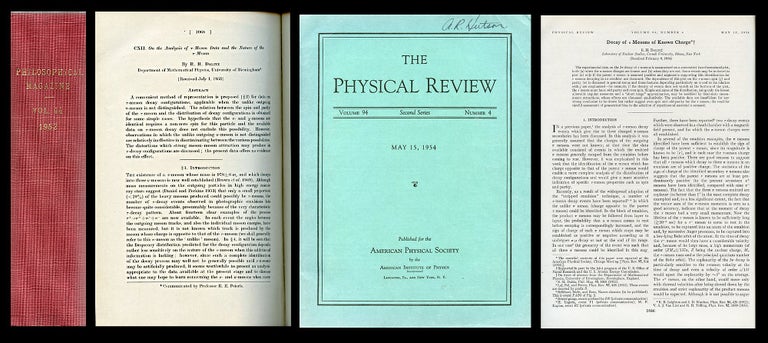On the Analysis of -Meson Data and the Nature of the -Meson in The Philosophical Magazine, Vol. XLIV, 1953, pp. 1068-1080 WITH Decay of Mesons of Known Charge in The Physical Review, 94, 4, May 15, 1954, pp. 1046-1052
1st Edition. FIRST EDITIONS, ONE IN ORIGINAL WRAPS OF DALITZ’S 1953 & 1954 PAPERS ANNOUNCEMENT & DEVELOPMENT OF THE ‘DALITZ PLOT’ — A MAJOR BREAKTHROUGH IN 20TH CENTURY PARTICLE PHYSICS. The Physical Review issue is in original wraps; the Phil Mag paper is a bound volume.
The Dalitz plot is part of the vocabulary of physics. The Dalitz plot “is a ternary plot often used in particle physics to represent the relative frequency of various (kinematically distinct) manners in which the products of certain (otherwise similar) three-body decays may move apart. Dalitz plots play a central role in the discovery of new particles in current high-energy physics experiments, including Higgs boson research, and are tools in exploratory efforts that might open avenues beyond the standard model.
While studying particle physics and ‘strange’ particles produced in cosmic-ray collisions, Dalitz “started to think particularly about the nature of one of these, the 'tau meson', or K+, as it is now known.
R.H. Dalitz introduced this technique [the Dalitz Plot in these papers] in 1953 to study decays of K mesons (which at that time were still referred to as ‘tau-mesons’. “ After completing his thesis, which was on transitions between spin states in the oxygen nucleus, Dalitz was finally able to concentrate on particle physics and study of the tau” (Oxford Dictionary of National Biography).
“The result was two seminal contributions that bear his name: the study of the decay of the neutral pion (one of the lightest mesons, a class of particles now identified as quark–antiquark pairings) to a photon and an electron–positron, or 'Dalitz', pair; and the development of the 'Dalitz plot’ [these papers]. This plot presents the kinematic variables of the three-body final state of a reaction in two dimensions. This allowed so-called resonances — transient states that flag their existence through their decay to final-state particles of definite total energy — to be readily visible” (Ross, Nature 440, 162, 9 March 2006 Obituary).
“Dalitz invented a way of mapping the data on a diagram, the ‘Dalitz plot’, and showed that the tau and theta modes were from the same particle. This could only be true if nature distinguished left from right, which ran counter to the received wisdom” (Oxford Dictionary of National Biography).
T. D. Lee and C. N. Yang later realized that the Dalitz Plot or law “had never been tested in weak interactions which were responsible for these decays. Dalitz’s plot thus set in train the sequence of events that led to Lee and Yang’s Nobel prize in 1957” (ibid). Item #897
CONDITION & DETAILS: London: Taylor & Francis [Phil Mag]. Lancaster: American Physical Society [Physical Review]. Phil Mag: Ex-libris and bearing occasional light stamp within. No marks at the spine whatsoever. Thick octavo (10 x 7 inches; 250 x 175mm). Ex-libris and bearing occasional light stamp within. New end papers. No marks at the spine whatsoever. Octavo (8.5 x 5.5 inches; 213 x 138mm). [4], xvi, [1421], 4. 52 plates. Bound in red cloth, gilt-lettered on the spine. Very slight rubbing at the edges. Tightly and very solidly bound. Bright and very clean throughout. Very good condition. Physical Review: October 1, 1954. Pp. 191-196. (10.5 x 8 inches; 262 x 200mm). Complete issue in original printed wrappers; slight rubbing at the edges; one pen mark at the spine and an ownership signature at the head of the front wrap.
Price: $500.00

